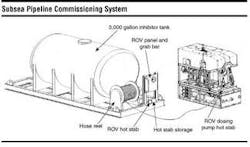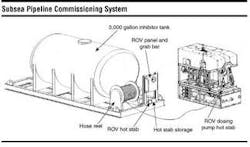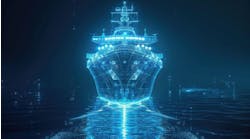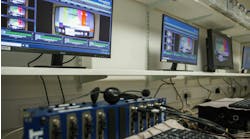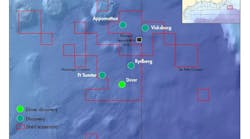Commissioning deepwater pipelines is a standard part of any subsea installation, but as operators look for ways to reduce expenses, a small firm has developed a process to commission these pipelines from the seafloor, reducing the need for large installation vessels and comprehensive surface equipment spreads.
Commissioning
Once a pipeline or infield flowline is laid offshore, it must be tested to ensure that it will perform as designed and was not damaged during installation. Pipeline commissioning is a critical component of installation since the contractor is often not paid until the pipeline successfully completes several procedures, which make up the commissioning process. Typically involving pigging, hydrostatic testing, de-watering, and nitrogen purging of the line, the commissioning process is usually a concluding stage of the installation process.
A first stage of commissioning is the pigging. A gauging plate on a pig is installed at one end of the line before it is lowered to the seabed. Fluid is then pumped into the pipeline to push the pig all the way through the line. When the pig is recovered at the other end of the line, the gauging plate is examined for damage around the edges. Because this plate has an outside diameter very close to the inside diameter of the pipeline, damage around its edge indicates there might be some ovality buckling, or other damage to the pipeline. Many pipeline installation contracts contain terms that approve payment only after the gauging plate has been accepted by the operator.
Subsea-to-subsea
For infield flow lines in deepwater, the length of the pipeline is often less than the water depth. This relationship virtually requires these lines to be laid subsea to subsea. David Tucker, Senior Vice President at Valkyrie Commissioning Services, explains that this term typically describes a line laid flat on the seabed without any access to the surface. This field architecture complicates efforts to commission the line from the surface.
The dewatering of the flowline can be a simple process when there is a riser attached to a surface facility. In a subsea-to-subsea commissioning situation, the process requires pressure be delivered to the pipeline on the seabed. Traditionally, this is accomplished by using a coiled tubing unit (CTU) mounted on a surface facility or large vessel. The CTU drives either inhibited seawater or compressed nitrogen down the narrow annulus of the coiled tubing. The coiled tubing is hot stabbed via remotely operated vehicle (ROV) into the one end of the pipeline on the seabed. The pressure of the water, or gas, drives the pig through the line into a receiver at the other end.
Because the distance to surface is very long in deepwater, and the annulus of the coiled tubing is narrow, typically less than 3-in., compared to the diameter of the flowline, the pigging procedure can be a slow process.
The topside spread of the CTU operation also includes high-pressure pumping, compression, booster, and nitrogen generation equipment. These systems have to generate a great deal of pressure, at least 3,000 psi, just to overcome the bottom pressure. In addition, friction loss over the entire length of the CTU further restricts flow and increases pressure requirements. The topside equipment spread can include as many as five skid packages measuring 20-ft by 8-ft and weighing 30,000 lbs each, Tucker said.
If there is room on the topside platform, this is not a problem, but in deepwater there often is not a fixed platform to work from. This means the pipeline installation vessel or a large, surface support vessel is required to be on station during the entire process. The associated vessel and equipment day rates, combined with the slow process of subsea commissioning from the surface can consume valuable project dollars.
Subsea option
Many projects are sensitive to the costs of such systems, particularly the vessel and equipment dayrates. To circumvent these requirements, Valkyrie has assembled a number of existing technologies that allow the subsea-to-subsea commissioning process to be performed from the seabed using an ROV-based system.
The Subsea Pipeline Commissioning System (SPCS) is the focus of a joint-venture between Valkyrie and Sonsub Inc. Valkyrie President Vince Kouns said the venture with Sonsub will combine Valkyrie's understanding of pipeline commissioning with Sonsub's experience in ROV operations and tooling technology. The two companies will have access to both organizations' equipment and personnel including vessels, ROVs, and commissioning related equipment.
SPCS technology uses field proven subsea pumping equipment, mounted on an ROV system, and attached to the flowline at the seabed.
"Everything is done subsea," Kouns said.
Sonsub is a Saipem group company. Bruce C. Gilman, President and CEO, said the joint venture is a good fit for his company. "Sonsub has extensive construction support experience, and this fits our strategy to participate in all aspects of subsea construction activity," he said.
Surface supporting equipment for the SPCS is reduced to a smaller vessel or DSV to support the ROV-based procedures. The ROV skid packages that make up SPCS are capable of filling, gauging, hydrostatic testing, chemical injection (up to 3,000 gallons), de-watering, and nitrogen packing. The system is divided into two skid packages, each weighing up to 2 tons, designed to perform different functions for the operator. Tucker said one skid package is configured to carry the equipment needed to pig the line, perform a high-pressure test, and inject the required chemicals to protect the line once it is temporarily abandoned. The second skid package performs the dewatering and nitrogen packing process. Tucker said this ability to perform these procedures from the seafloor allows operators and installation contractors more options to commission their pipelines and is a key driver for tackling the commissioning process from the seafloor.
The individual ROV components used in SPCS are common to other ROV applications, such as cable burial and BOP drilling. From this perspective, these are essentially proven components applied to a new procedure. When compared to the coiled tubing commissioning method, Tucker said, savings are estimated to reach 25%-30%.
In some cases, the coiled tubing method is not an option due to flow restrictions caused by diameter limitations of the coiled tubing unit itself. In these instances, the installation contractor must either keep the installation vessel on location to hold the pipeline while the pipeline is gauged and tested or wait until the entire pipeline system is tied-in to processing facilities.
Complementing the recent development of ROV reloadable pig launchers, operators are able to aid flow assurance teams without building a second pipeline to return the pigs via a pigging loop. Additionally, as deepwater infrastructure is built, many pipelines are incorporating "Ys" to allow for future tie-in points. In cases, the "Ys" only allow a pig to travel in one direction. Hence the pigs must travel from the deep end to the shallow. SPCS supports this new field architecture by providing a cost-effective option for the operator to commission the one-way single pipeline.
Valkyrie filed for patent protection from the US Government to safeguard their investment in SPCS technology. The company is bidding projects using the system.
